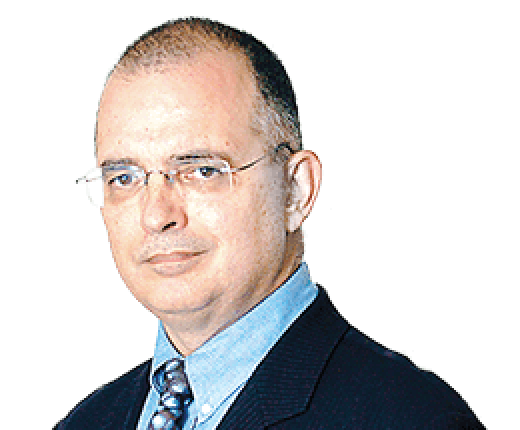The current debate about the proposed Indigenous voice to parliament is impossible to separate from the Uluru Statement from the Heart, which is where everything began.
This document, drawn up in May 2017, outlines an agenda for change that has been endorsed by the Labor Party and was even presented to the Pope. It won last year’s Sydney Peace Prize and in some states it is being taught and discussed in schools.
But here’s rub: the most poetic part of this document, the section that refers to sovereignty as a spiritual notion, is not original and the real author was referring to Africans, not Aborigines and Torres Strait Islanders.
It was copied from a 1975 ruling of the International Court of Justice that concerned the people of the Western Sahara.
The primary author of that passage was a gifted jurist from Zaire, Nicolas Bayona-Ba-Meya, whose submission to the court was picked up and incorporated in the ruling handed down by judge Fouad Ammoun, the court’s Lebanese vice-president.
This link between the Uluru statement and the work of Bayona-Ba-Meya and Fouad Ammoun is outlined in a new book on the voice by Jesuit priest and lawyer Frank Brennan.
He points out the words from Ammoun’s judgment in the Western Sahara case found their way to Australia in 1992, when they were reproduced in the High Court’s Mabo ruling that overturned the doctrine of terra nullius – that Australia was an empty land owned by nobody.
From there, Brennan writes that an adapted version found its way into the Uluru statement. The similarity between Uluru and the passage in Ammoun’s judgment about the Western Sahara is uncanny.
Consider the third paragraph of the Uluru statement that concludes with the assertion that Indigenous sovereignty has never been ceded or extinguished and coexists with the sovereignty of the Crown.
That paragraph starts by describing sovereignty as “a spiritual notion: the ancestral tie between the land, or ‘mother nature’, and the Aboriginal and Torres Strait Islander peoples who were born therefrom, remain attached thereto, and must one day return thither to be united with our ancestors. This link is the basis of the ownership of the soil, or better, of sovereignty”.
This is the only section of the Uluru statement that uses archaic forms of language and, according to Brennan: “Not many 21st century Aboriginal Australians use terms like therefrom, thereto and thither.”
Now consider Ammoun’s original passage, which uses those archaic terms and which appeared twice in the Mabo judgment.
The Lebanese judge wrote that the submission of Bayona-Ba-Meya substitutes for terra nullius “a spiritual notion: the ancestral tie between the land, or ‘mother nature’, and the man who was born therefrom, remains attached thereto, and must one day return thither to be united with his ancestors. This link is the basis of the ownership of the soil, or better, of sovereignty”.
With only superficial changes, the Uluru statement reproduces this entire passage, right down to the colon after the first three words, without attribution to either the High Court, Ammoun or, more importantly, Bayona-Ba-Meya, who conceived of sovereignty as a spiritual concept.
The only changes from Ammoun’s original wording are Uluru’s insertion of the words “Aboriginal and Torres Strait Islander peoples” instead of Ammoun’s reference “the man” and the subsequent reference to “our” ancestors instead of “his” ancestors.
If political and legal differences about the voice and Indigenous sovereignty are put to one side, there can be no doubt the power of the idea at the core of the Uluru statement provides compelling evidence that a gifted jurist was at work.
But that jurist was an African, Nicolas Bayona-Ba-Meya, who was senior president of the Supreme Court of Zaire and appeared before the international court on behalf his government.
It is the power of his idea that underpins the Uluru statement. He does not deserve to be airbrushed out of the history of a document that, until now, has been viewed by many Indigenous Australians as entirely homegrown.
The High Court in Mabo has shown that Bayona-Ba-Meya’s concept of sovereignty can have a legitimate impact beyond the Western Sahara, so there is nothing wrong with including this man’s work in the Uluru statement. But it would have been good manners to have acknowledged his authorship and the role of Ammoun – as was done by the High Court in Mabo.
The fact that the ideas outlined in the Uluru statement are not entirely original is not a fatal flaw. Nor is it fatal that the original reference to spiritual sovereignty concerned Africans, not Aborigines and Torres Strait Islanders.
Ideas retain their power regardless of their origins. But failing to acknowledge the source of Uluru’s big idea leaves this document vulnerable to the accusation of cultural appropriation.
If the Uluru statement is to be taught in schools, children should be taught the truth: it is not entirely original and not entirely homegrown.
They should be taught that Uluru’s concept of sovereignty as a spiritual notion is the work of others and originally referred to Africans in the Western Sahara, not Aborigines and Torres Strait Islanders.
It should come as no surprise that the true origin of this part of the Uluru statement was tracked down by Brennan.
He happens to be the son of the late Sir Gerard Brennan, the author of the leading judgment in Mabo that first cites the jurisprudence of Ammoun and the International Court of Justice.
Chris Merritt is vice-president of the Rule of Law Institute of Australia. Frank Brennan’s book, An Indigenous Voice to Parliament – Considering a Constitutional Bridge, is published by Garratt Publishing.



